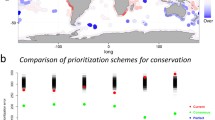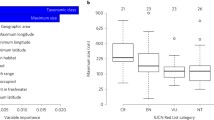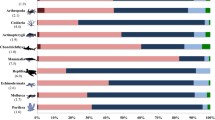Abstract
Oceanic islands have been the grand stage of documented extinctions. In view of limited resources, efficient prioritization is crucial to avoid the extinction of taxa. This work lists the top 100 management priority species for the European archipelagos of the Macaronesian region (Azores, Madeira and the Canary Islands), taking into account both their protection priority and their management feasibility. Bryophytes, vascular plants, molluscs, arthropods and vertebrates were scored by species experts following two sets of criteria: (i) protection priority, including ecological value, singularity, public institutions’ management responsibilities and social value; (ii) management feasibility, including threats knowledge and control feasibility, external socio-economical support for management and biological recovery potential. Environmental managers weighted the same criteria according to their management importance. Final species scores were determined by the combination of both species valuation and criteria weighting. Vascular plants dominate the Top 100 list, followed by arthropods and vertebrates. The majority of listed taxa are endemic to one archipelago or even to a single island. The management feasibility criteria did not dictate that all taxa must be eminently endangered, as for most of the species it should be relatively easy to control threats. The main advantages of this process are the independent participation of scientists and conservation managers, the inclusion of criteria on both protection priority and management feasibility and the taxonomically unbiased nature of the process. This study provides a potentially useful biodiversity conservation tool for the Macaronesian archipelagos that could be readily implemented by the respective regional governments in future legislation.



Similar content being viewed by others
References
Arechavaleta M, Martín JL (2008) La perspectiva archipelágica: Canarias. In: Martín JL, Arechavaleta M, Borges PAV, Faria B (eds) Top 100—Las cien especies amenazadas prioritarias de gestión en la región europea biogeográfica de la Macaronesia. Consejería de Medio Ambiente y Ordenación Territorial, Gobierno de Canarias, Santa Cruz de Tenerife, Spain, pp 129–145
Baillie JEM, Collen B, Amin R et al (2008) Toward monitoring global biodiversity. Conserv Lett 1:18–26
Biber E (2002) Patterns of endemic extinctions among island bird species. Ecography 25:661–676
Borges PAV, Aguiar C, Amaral J et al (2005a) Ranking protected areas in the Azores using standardized sampling of soil epigean arthropods. Biodivers Conserv 14:2029–2060
Borges PAV, Cunha R, Gabriel R et al (2005b) Description of the terrestrial Azorean biodiversity. In: Borges PAV, Cunha R, Gabriel R (eds) A list of the terrestrial fauna (Mollusca and Arthropoda) and flora (Bryophyta, Pteridophyta and Spermatophyta) from the Azores. Direcção Regional de Ambiente and Universidade dos Açores. Horta, Angra do Heroísmo and Ponta Delgada, Portugal, pp 21–68
Borges PAV, Abreu C, Aguiar AMF et al (2008) Description of the Madeira and Selvagens archipelagos terrestrial and freshwater biodiversity. In: Borges PAV, Abreu C, Aguiar AMF (eds) A list of the terrestrial fungi, flora and fauna of Madeira and Selvagens archipelagos. Direcção Regional do Ambiente da Madeira and Universidade dos Açores, Funchal and Angra do Heroísmo, Portugal, pp 13–26
Bottrill MC, Joseph LN, Carwardine J et al (2008) Is conservation triage just smart decision making? Trends Ecol Evol 23:649–654
Bouchet P, Falkner G, Seddon MB (1999) Lists of protected land and freshwater molluscs in the Bern Convention and European Habitats Directive: are they relevant to conservation? Biol Conserv 90:21–31
Brook BW, Sodhi NS, Ng PKL (2003) Catastrophic extinctions follow deforestation in Singapore. Nature 424:420–423
Cabeza M, Arponen A, Van Teeffelen A (2008) Top predators: hot or not? A call for systematic assessment of biodiversity surrogates. J Appl Ecol 45:976–980
Cardoso P, Borges PAV, Gaspar C (2007) Biotic integrity of the arthropod communities in the natural forests of Azores. Biodivers Conserv 16:2883–2901
Cardoso P, Borges PAV, Costa AC et al (2008) La perspectiva archipelágica: Azores. In: Martín JL, Arechavaleta M, Borges PAV, Faria B (eds) Top 100—Las cien especies amenazadas prioritarias de gestión en la región europea biogeográfica de la Macaronesia. Consejería de Medio Ambiente y Ordenación Territorial, Gobierno de Canarias, Santa Cruz de Tenerife, Spain, pp 79–107
Cardoso P, Arnedo MA, Triantis KA, Borges PAV (in press) Drivers of diversity in Macaronesian spiders and the role of species extinctions. J Biogeogr. doi:10.1111/j.1365-2699.2009.02264.x
Dalton TM (2005) Beyond biogeography: a framework for involving the public in planning of U.S. marine protected areas. Conserv Biol 19:1392–1401
Duncan RP, Blackburn TM (2007) Causes of extinction in island birds. Anim Conserv 10:149–150
Faria BF, Abreu C, Aguiar AF (2008) La perspectiva archipelágica: Madeira. In: Martín JL, Arechavaleta M, Borges PAV, Faria B et al (eds) Top 100—Las cien especies amenazadas prioritarias de gestión en la región europea biogeográfica de la Macaronesia. Consejería de Medio Ambiente y Ordenación Territorial, Gobierno de Canarias, Santa Cruz de Tenerife, Spain, pp 109–128
Ferrier S, Pressey RL, Barrett TW (2000) A new predictor of the irreplaceability of areas for achieving a conservation goal, its application to real-world planning, and a research agenda for further refinement. Biol Conserv 93:303–325
Fontinha S, Sim-Sim M, Sérgio C, Hedenäs L (2001) Briófitos Endémicos da Madeira. Biodiversidade Madeirense: Avaliação e Conservação, vol 1. Direcção Regional do Ambiente and Secretaria Regional do Ambiente e dos Recursos Naturais, Funchal, Portugal
Frankham R (2005) Genetics and extinction. Biol Conserv 126:131–140
Gaston KJ (1994) Rarity. Chapman and Hall, London
Holmes CM (2003) The influence of protected area outreach on conservation attitudes and resource use patterns: a case study from western Tanzania. Oryx 37:305–315
IUCN (2008) Guidelines for using the IUCN red list categories and criteria, version 7.0. http://intranet.iucn.org/webfiles/doc/SSC/RedList/RedListGuidelines.pdf. Accessed 13 May 2009
Izquierdo I, Martín JL, Zurita N, Arechavaleta M (eds) (2004) Lista de especies silvestres de Canarias (hongos, plantas y animales terrestres). Consejería de Política Territorial y Medio Ambiente del Gobierno de Canarias, Spain
Jardim R, Fernandes F, Carvalho JA (2006) Flora Vascular. Fauna e Flora da Madeira, Espécies Endémicas Ameaçadas. Vertebrados e Flora Vascular. Governo Regional da Madeira, Funchal, Portugal
Jeffrey DW (2001) The roles of environmental non-governmental organisations in the next century. Biol Environ Proc R Irish Acad 101:151–156
Johnson KN, Duncan S, Spies TA (2007) Regional policy models for forest biodiversity analysis: lessons from coastal Oregon. Ecol Appl 17:81–90
Klemm C, Shine C (1993) Biological diversity conservation and the law: legal mechanisms for conserving species and ecosystems. Environmental Policy and Law Paper 29. IUCN, Gland, Switzerland
Lawton JH (2000) Community ecology in a changing world. International Ecology Institute, Oldendorf/Luhe, Germany
Lawton JH, May RM (1995) Extinction rates. Oxford University Press, Oxford
Linstone HA, Turoff M (eds) (1975) The Delphi method: techniques and applications. Addison-Wesley Publishing Company, Reading, MA
Machado A (2004) An index of naturalness. J Nat Conserv 12:95–110
Manne LL, Pimm SL (2001) Beyond eight forms of rarity: which species are threatened and which will be next? Anim Conserv 4:221–230
Manne LL, Brooks TM, Pimm SL (1999) The relative risk of extinction of passerine birds on continents and islands. Nature 399:258–261
Margules CR, Pressey RL (2000) Systematic conservation planning. Nature 405:243–253
Margules CR, Sarkar S (2007) Systematic conservation planning. Ecology, biodiversity and conservation series. Cambridge University Press, Cambridge
Marsh H, Denis A, Hines H et al (2007) Optimizing allocation of management resources for wildlife. Conserv Biol 21:387–399
Martín JL (2009) Are the IUCN standard home-range thresholds for species a good indicator to prioritize conservation urgency in small islands? A case study in the Canary Islands (Spain). J Nat Conserv 17:87–98
Martín JL, Fajardo S, Cabrera MA et al (2005) Evaluación 2004 de especies amenazadas de Canarias. Especies en peligro de extinción, sensibles a la alteración de su hábitat y vulnerables. Consejería de Medio Ambiente y Ordenación Territorial. Gobierno de Canarias, Santa Cruz de Tenerife, Spain
Martín JL, Arechavaleta M, Borges PAV, Faria BF (eds) (2008) Top 100—Las cien especies amenazadas prioritarias de gestión en la región europea biogeográfica de la Macaronesia. Consejería de Medio Ambiente y Ordenación Territorial. Gobierno de Canarias, Santa Cruz de Tenerife, Spain
Myers N, Mittermeier RA, Mittermeier G et al (2000) Biodiversity hotspots for conservations priorities. Nature 403:853–858
Paulay G (1994) Biodiversity on oceanic islands: its origin and extinction. Am Zool 34:134–144
Pressey RL, Johnson IR, Wilson PD (1994) Shades of irreplaceability: towards a measure of the contribution of sites to a reservation goal. Biodivers Conserv 3:242–262
Quammen D (1997) The song of dodo: island biogeography in an age of extinction. Simon and Schuster, New York
Rabinowitz D (1981) Seven forms of rarity. In: Synge H (ed) The biological aspects of rare plant conservation. Wiley, Chichester, UK, pp 205–217
Restani M, Marzluff JM (2002) Funding extinction? Biological needs in the allocation of resources to endangered species recovery. Bioscience 52:169–177
Roberge JM, Angelstam P (2004) Usefulness of the umbrella species concept as a conservation tool. Conserv Biol 18:76–85
Roth T, Weber D (2008) Top predators as indicators for species richness? Prey species are just as useful. J Appl Ecol 45:987–991
Sadler JP (1999) Biodiversity on oceanic islands: a paleoecological assessment. J Biogeogr 26:75–87
Santana I, Valdés F, Luis JC (2006) Micropropagation of Helianthemum inaguae, a rare and endangered species from the Canary Islands. Bot Macaronesica 26:55–64
Sax DF, Gaines SD, Brown JH (2002) Species invasions exceed extinctions on islands worldwide: a comparative study of plants and birds. Am Nat 160:766–783
Schmeller DS, Gruber B, Budrys E et al (2008) National responsibilities in European species conservation: a methodological review. Conserv Biol 22:593–601
Sergio F, Newton I, Marchesi L, Pedrini P (2006) Ecologically justified charisma: preservation of top predators delivers biodiversity conservation. J Appl Ecol 43:1049–1055
Steadman DW, Martin PS (2003) The late quaternary extinction and future resurrection of birds on Pacific Islands. Earth Sci Rev 61:133–147
UNEP (2002) Report on the sixth meeting of the conference of the parties to the Convention on Biological Diversity (UNEP/CBD/COP/6/20/Part2) Strategic Plan Decision VI/26
Wood LJ, Fish L, Laughren J, Pauly D (2008) Assessing progress towards global marine protection targets shortfalls in information and action. Oryx 42:340–351
Acknowledgements
The generation of the Top 100 list was one of the objectives of the BIONATURA Interreg IIIB project, with the cooperation of ARENA (Azores), Direcção Regional do Ambiente (Madeira) and Dirección General del Medio Natural del Gobierno de Canarias. We are grateful to the following people: Gustavo Vieira, from MBA-consultores, who was the administrative coordinator of the three archipelagos’ associates and responsible for the Interreg secretariat. Sara Santos, who acted as liaison between the researchers of the University of the Azores and Direcção Regional do Ambiente e do Mar (Azores). Elizabeth Ojeda, María Nieves Zurita, Silvia Fajardo and Sofía Rodríguez, who helped in the organization of expert workshops and in finding information for Canary taxa. José Ramón Docoito and Beatriz Herrera, who were in charge of the travel logistics. Salvador de la Cruz, who coordinated the work of experts in the evaluation of target taxa in the Canary Islands. Julián Arechavaleta, who helped with the analyses and software tools. Environmental managers from several public or private institutions from the three archipelagos weighted the priority criteria: António Domingos Abreu, Ángel Bañares, Maria José Bettencourt, Maria Botelho, Miguel Ángel Cabrera, Ana Calero, Bárbara Chaves, José Alberto Delgado, Silvia Fajardo, Ángel Fernández, Manuel Filipe, Paulo Freitas, Mercedes González, María Ángeles Llaría, Nuno Loura, Manuel Martín, Elena Mateo, Félix Medina, João Melo, Dília Menezes, Duarte Nunes, Nuno Pacheco, Paulo Pimentel, Juan Carlos Rando, Pedro Raposo, Miguel Ángel Rodríguez and Rui Sequeira. The evaluators of target taxa, apart from this work’s authors, were: Aurelio Acevedo, Ana Cabrera, Eduardo Carqué, Salvador de la Cruz, Juan Domingo Delgado, José Ramón Docoito, Silvia Fajardo, Eduardo García del Rey, Heriberto López, Manuel Marrero, Katia Martín, José Antonio Mateo, Ricardo Mesa, Helena Morales, José Naranjo, Manuel Naranjo, Elizabeth Ojeda, Alfredo Reyes, María Leticia Rodríguez, Sofía Rodríguez, Rogelio Herrera, Arnoldo Santos and Stephan Scholz. Additionally, Guillermo Delgado and Juan Luis Rodríguez Luengo have participated in workshops for evaluating threatened species.
Author information
Authors and Affiliations
Corresponding author
Appendix
Rights and permissions
About this article
Cite this article
Martín, J.L., Cardoso, P., Arechavaleta, M. et al. Using taxonomically unbiased criteria to prioritize resource allocation for oceanic island species conservation. Biodivers Conserv 19, 1659–1682 (2010). https://doi.org/10.1007/s10531-010-9795-z
Received:
Accepted:
Published:
Issue Date:
DOI: https://doi.org/10.1007/s10531-010-9795-z




